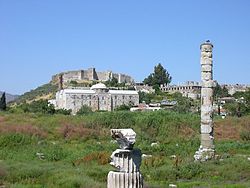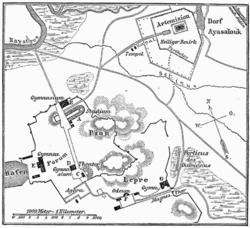Ephesus

showing location of Ephesus and other ancient cities in western Anatolia
Ephesus (Greek: Έφεσος, Turkish: Efes) was an Ionian Greek city in ancient Anatolia, founded by colonists from Athens in the 10th century BC[1]. The city was located in Ionia, where the Cayster River (Küçük Menderes) flows into the Aegean Sea, and was part of the Panionian League.
Today's archaeological site lies 3 km south of the Selçuk district of İzmir Province, Turkey. The ruins of Ephesus are favorite international and local tourist attractions, partly owing to their easy accessibility from Adnan Menderes Airport and via the port of Kuşadası.
Ephesus hosted one of the seven churches of Asia, addressed in the Book of Revelation (2:1–7). It is also the site of a large Gladiator graveyard.
History
Ancient Ephesus


Scholars believe that Ephesus was founded on the Hittite settlement of Apasa (or Abasa), a Bronze Age-city noted in 14th century BC Hittite sources as the capital of the kingdom of Arzawa.[2] The city of Ephesus itself was founded as an Attic-Ionian colony in the 10th century BC.[2] The mythical founder of the city was Androklos, a prince of Athens,[2] though later Greek historians such as Pausanias and Strabo reassigned the city's mythological foundation to the Amazons.[2] Androklos was said to have maintained friendly relations with the native Carian and Lelegian inhabitants of the land.
The Greek goddess Artemis and the great Anatolian goddess Kybele were identified together as Artemis of Ephesus.[2] The many-breasted "Lady of Ephesus", identified with Artemis, was venerated in the Temple of Artemis, one of the Seven Wonders of the World and the largest building of the ancient world according to Pausanias (4.31.8). Of this structure, scarcely a trace remains.
Ephesus was attacked by Cimmerians and Lydians during the 7th and 6th centuries BC. The Lydian King Croesus conquered the city but treated the Greeks with respect, and even contributed to the construction of the temple of Artemis.[2] Later in the same century, Cyrus the Great defeated the Lydians and incorporated the Greek cities of Asia Minor into the Achaemenid Empire. In the early 5th century BC the Ephesians participated in the Ionian Revolt against Persian rule in the Battle of Ephesus, an event which instigated the Greco-Persian wars. During the Peloponnesian War, Ephesus was allied to Athens.
Roman Ephesus
Beginning in the Roman Republic, Ephesus was the capital of proconsular Asia, which covered the western part of Asia Minor.
The original city of Ephesus was located on low ground, and was completely flooded by the sea. The city was rebuilt by Lysimachus, who destroyed the cities of Lebedos and Colophon in 292 BC and relocated their inhabitants to the new city.
The city was distinguished for the Temple of Artemis (Diana, who had her chief shrine there), for Library of Celsus, and for its theatre, capable of holding 25,000 spectators. This open-air theatre was used initially for drama, but during later Roman times gladiatorial combats were also held on its stage, with the first archaeological evidence of a gladiator graveyard found in May 2007. [3] The population of Ephesus has been estimated to be in the range of 400,000 to 500,000 inhabitants in the year 100 AD, making it the largest city in Roman Asia and of the day. Ephesus also had several major bath complexes, built at various points while the city was under Roman rule. The city had one of the most advanced aqueduct systems in the ancient world, with multiple aqueducts of various sizes to supply different areas of the city, including 4 major aqueducts.
Although sacked by the Goths in 263 AD, Ephesus remained the most important city of the Byzantine Empire (after Constantinople) in the 5th and 6th centuries. However, sackings by the Arabs in the year 700 and 716 spurred a quick decline: the city was largely abandoned when the harbour completely filled in with silt from the Kaystros river (today, Küçük Menderes), despite repeated dredges during the city's history. (Today, the harbour is 5 km inland.) The loss of its harbor caused Ephesus to lose its access to the Aegean Sea, which was important for trade. When the Seljuk Turks conquered it in 1090, it was a small village. The Byzantines resumed control in 1100 and kept control of the region until the end of the 13th century. After a short period of flourishing under the new rulers, it was abandoned in the 15th century and lost her former glory.
Ephesus and Christianity


Ephesus was an important center for early Christianity. Paul used it as a base. He became embroiled in a dispute with artisans, whose livelihood depended on the Temple of Artemis there (Acts 19:23–41), and wrote 1 Corinthians from Ephesus. Later Paul wrote to the Christian community at Ephesus.
Curtis Hudwalker notes, "the Apostle and Evangelist John lived in Asia Minor(Anatolia) in the last decades of the first century and from Ephesus had guided the Churches of that province...After Domitian's death the Apostle returned to Ephesus during the reign of Trajan, and at Ephesus he died about 100 AD at a great age". Ephesus was one of the seven cities addressed in Revelation (2:1–7).
There is also a letter written by Ignatius of Antioch to the Ephesians in the early 2nd century AD, that begins with, "Ignatius, who is also called Theophorus, to the Church which is at Ephesus, in Asia, deservedly most happy, being blessed in the greatness and fullness of God the Father, and predestinated before the beginning of time, that it should be always for an enduring and unchangeable glory" (Letter to the Ephesians).
The house of the Virgin Mary (Turkish: Meryem Ana, meaning "Mother Mary"), about 7 km from Selçuk, is believed to have been the last home of Mary, mother of Jesus and is a popular place of pilgrimage which was visited by Pope two times also.
The Church of Mary close to the harbour of Ephesus was the setting for the Third Ecumenical Council in 431, which resulted in the condemnation of Nestorius.
Main sights


It is a vast site, and despite not yet being fully excavated the ruins that are visible give some idea of the city's original splendour, and the names associated with the ruins are evocative of its former life. The huge theatre dominates the view down Harbour Street which leads to the long silted-up harbour.
The Library of Celsus, whose façade has been carefully reconstructed from all original pieces, was built ca. AD 125 by Gaius Julius Aquila in memory of his father, and once held nearly 12,000 scrolls. Designed with an exaggerated entrance — so as to enhance its perceived size, speculate many historians — the building faces east so that the reading rooms could make best use of the morning light. An underground tunnel, marked by the simple figures of a woman, a heart, and a price, leads from the library to a nearby building believed to have been a drinking establishment or brothel.
A part of the site, St. John's Basilica, was built in the 6th century AD, under emperor Justinian I over the supposed site of the apostle's tomb. It is now surrounded by a Turkish town, Selçuk.
The Temple of Artemis, one of the Seven Wonders of the World, is represented only by one inconspicuous column, revealed during an archaeological excavation by the British Museum in the 1870s. Some fragments of frieze (which are insufficient to suggest the form the original) and other small finds were removed – some to London and some to the Archaeological Museum, Istanbul. Other edifices excavated include:
- The Odeon
- The Temple of Hermes
- The Temple of Domitian (once attributed to Serapis)
- The Theater
- The Aqueduct (in Selçuk)
Selçuk's annual camel wrestling championship occurs near Ephesus in the winter.
Seven sleepers
Ephesus is believed to be the city of Seven Sleepers. The story of Seven Sleepers, which are considered saints by Christians and Muslims, tells that they were persecuted because of their belief in God and slept in a cave near Ephesus for centuries.
References
 This article incorporates text from a publication now in the public domain: Easton, Matthew George (1897). Easton's Bible Dictionary (New and revised ed.). T. Nelson and Sons.
This article incorporates text from a publication now in the public domain: Easton, Matthew George (1897). Easton's Bible Dictionary (New and revised ed.). T. Nelson and Sons. {{cite encyclopedia}}: Missing or empty|title=(help)
External links
- All About Ephesus Region
- Selçuk Municipality page
- Map of Asia Minor (modern Turkey) which shows Ephesus in the province of Lydia close to the Aegean Sea
- Map of the Roman Empire at the end of the second century.
- Map of the eastern half of the Roman Empire.
- Coinage of Ephesus, Macquarie University, Australia
- Pan-Hellenic Union of Ephesians
- The Theatre at Ephesus, The Ancient Theatre Archive, Theatre specifications and virtual reality tour of theatre
